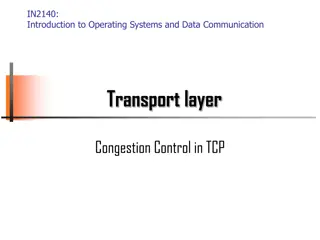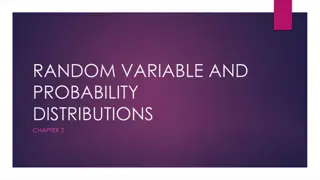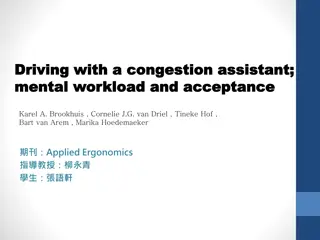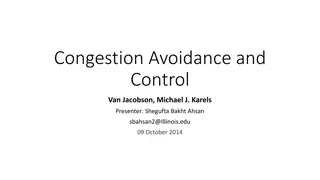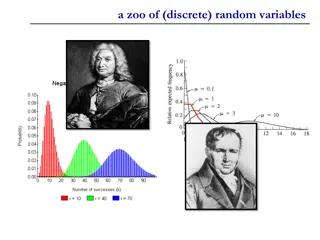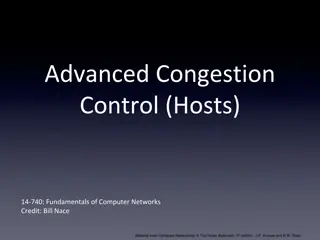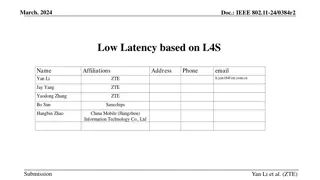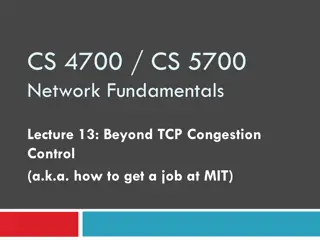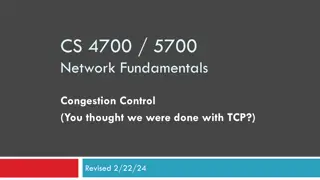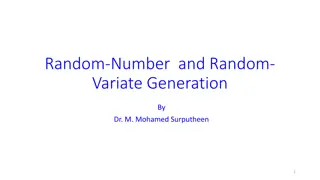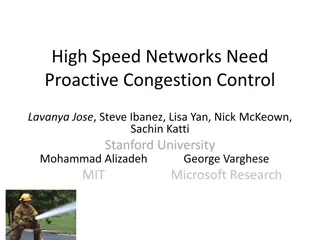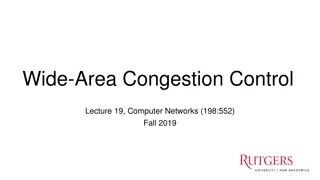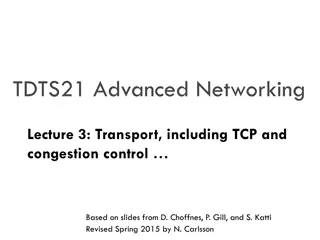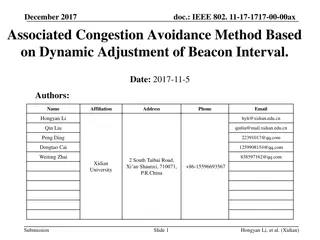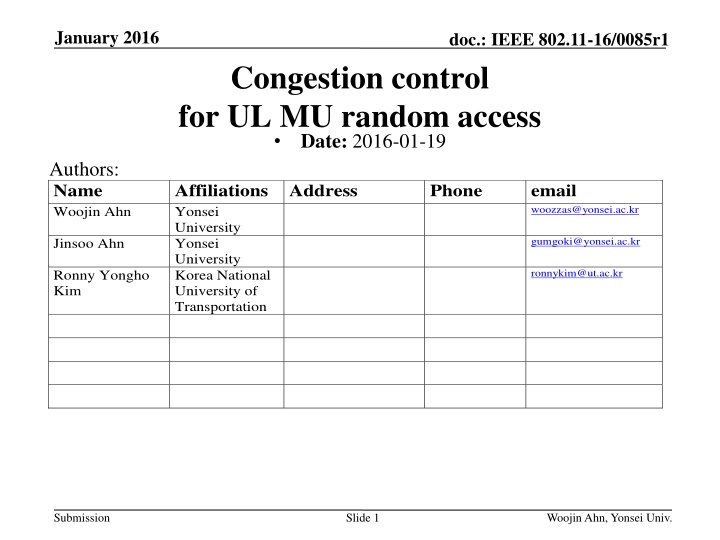
IEEE 802.11-16/0085r1: Congestion Control for UL MU Random Access
Delve into the 2016 document regarding congestion control for UL MU random access in IEEE 802.11-16/0085r1. This document discusses the utilization of transmission probability as a congestion control parameter, offering simulation results to demonstrate its impact on network throughput.
Download Presentation

Please find below an Image/Link to download the presentation.
The content on the website is provided AS IS for your information and personal use only. It may not be sold, licensed, or shared on other websites without obtaining consent from the author. If you encounter any issues during the download, it is possible that the publisher has removed the file from their server.
You are allowed to download the files provided on this website for personal or commercial use, subject to the condition that they are used lawfully. All files are the property of their respective owners.
The content on the website is provided AS IS for your information and personal use only. It may not be sold, licensed, or shared on other websites without obtaining consent from the author.
E N D
Presentation Transcript
January 2016 doc.: IEEE 802.11-16/0085r1 Congestion control for UL MU random access Date: 2016-01-19 Authors: Name Woojin Ahn Affiliations Address Yonsei University Yonsei University Korea National University of Transportation Phone email woozzas@yonsei.ac.kr gumgoki@yonsei.ac.kr Jinsoo Ahn ronnykim@ut.ac.kr Ronny Yongho Kim Submission Slide 1 Woojin Ahn, Yonsei Univ.
January 2016 doc.: IEEE 802.11-16/0085r1 Abstract Discussing performance boundary UL MU random access Proposing to use transmission probability as a congestion control parameter (included in TF-R) for random access Providing simulation results that shows the effect of the transmission probability in terms of network throughput Submission Slide 2 Woojin Ahn, Yonsei Univ.
January 2016 doc.: IEEE 802.11-16/0085r1 Random Access (RA) for MU transmission A STA with OBO decremented to 0 randomly selects any one of the assigned RUs for random access and transmits its frame. [MU Motion 27, September 17, 2015, see [1]] RA prevents excessive overhead caused by point-to- point transmission control for UL MU Expected to be used for many applications such as Buffer Status Report (BSR), control frame, UL data Submission Slide 3 Woojin Ahn, Yonsei Univ.
January 2016 doc.: IEEE 802.11-16/0085r1 Acceptance rate of RA The acceptance rate of RA has analytical boundary Resemblance with slotted ALOHA Defined by the number of active STAs (OBO=0, Nt.STA) & assigned RUs (NRU) Maximum rate: 37% When Na.STA = NRU 20 MHz, 9 RUs 4 3.5 3 The performance of RA keeps decreasing from the maximum value as the number of active STAs increases Assigned RUs are occupied by collisions RA has the same RU utilization with SU when Na.STA is near 30 Acceptance rate 2.5 2 1.5 1 0.5 5 10 15 20 25 30 35 Number of transmitting STAs Submission Slide 4 Woojin Ahn, Yonsei Univ.
January 2016 doc.: IEEE 802.11-16/0085r1 Throughput analysis with Random Access BSR (RA BSR) [2] lmin: 0.5KB, lmax: 1KB RA BSR 22 RA-BSR SU 20 5 Col 18 Col 10 Throughput (Mbps) 16 Trigger Trigger MBA MBA STA 5, 8, 9, 10 14 8 12 Col Col 10 9 8 Measuring network throughput (1 BSS, 20 MHz) Repeating RA BSR, UL MU transmission Simple integer RU allocation without frequency selectivity Comparing to basic access SU transmission MU transmission with RA shows better throughput when congestion level is low HOWEVER, MU throughput drops much faster than SU The network throughput of SU is maintained by congestion control (exponential backoff) 6 5 10 15 20 25 30 35 Number of Active STAs lmin: 2KB, lmax: 5KB 42 RA-BSR SU 40 38 Throughput (Mbps) 36 34 32 30 28 26 5 10 15 20 25 30 35 Number of Active STAs Submission Slide 5 Woojin Ahn, Yonsei Univ.
January 2016 doc.: IEEE 802.11-16/0085r1 Congestion control parameter for RA An HE AP is allowed to broadcast a TBD parameter in the trigger frame to the STAs so that STAs can initiate the random access process after the trigger frames. [MAC Motion 41, September 17, 2015, see [3]] The TBD parameter can be used for enhancing the efficiency of RA Congestion control E.g., CWOmin or CWOmax, transmission probability We prefer transmission probability Submission Slide 6 Woojin Ahn, Yonsei Univ.
January 2016 doc.: IEEE 802.11-16/0085r1 Transmission probability pt for RA AP broadcasts pt with trigger frame for RA Format is TBD Optimal pt*: min(NRU, Na.STA)/Na.STA Active STAs attempt a Bernoulli trial with pt Only STAs with 0 OBO value (after OBO decrement) attempt the trial, and if fail, do not transmit (regarded as collision) Pt Common info field Duration Per STA Per STA Control Frame info n info 1 (RA) FCS ... TA 5 Col Trigger Trigger 10 MBA MBA STA 5, 8, 9, 10 8 Col Col 9 STA1 STA2 STA3 STA4 STA5 STA6 ... STA7 STA8 STA9 STA10 STA20 Bernoulli trial with probability pt Submission Slide 7 Woojin Ahn, Yonsei Univ.
January 2016 doc.: IEEE 802.11-16/0085r1 Comparison between CWO control and pt CWO control CWOcannot be applied to STAs that already have OBO Once a STA draws its OBO, it won t be affected by following CWO controls Most of the effect will be shown from the latter TF-Rs impossible to control the number of access attempts immediately pt Currently delivered pt is used for the following immediate response pt instantaneously affects current access behavior pt can be applied to every active STAs every time AP broadcasts it We find pt is more immediate and fairer Submission Slide 8 Woojin Ahn, Yonsei Univ.
January 2016 doc.: IEEE 802.11-16/0085r1 Calculating pt In order to calculate pt, AP requires the number of active STA (Na.STA) Finding the approximated Na.STA Tracing event history # of collision, success, no-access Measuring RSSI level of RA or simultaneous CTS Moving average of pt Several solutions can be applied for implementation Submission Slide 9 Woojin Ahn, Yonsei Univ.
January 2016 doc.: IEEE 802.11-16/0085r1 Performance analysis with pt lmin: 0.5KB, lmax: 1KB Measuring throughput enhancement of pt, and observing the effect of Na.STA estimation error Repeating the same simulation on slide 5 with different pt values pt = min(NRU, Na.STA)/ Na.STA : error scaling pt helps to maintain the throughput of MU RA near maximum regardless of increase of the number of active STAs pt still enhances the throughput of MU RA even with large amount of estimation error 22 20 18 1.4Na.STA 1.2Na.STA Na.STA 0.8Na.STA 0.6Na.STA Throughput (Mbps) 16 14 12 10 8 6 5 10 15 Number of Active STAs 20 25 30 35 Submission Slide 10 Woojin Ahn, Yonsei Univ.
January 2016 doc.: IEEE 802.11-16/0085r1 Conclusion In order to fully take advantage of UL MU random access, a proper congestion control mechanism is necessary a TBD parameter in TF can be used for congestion control of RA Simulation results shows that transmission probability successfully control the network congestion Submission Slide 11 Woojin Ahn, Yonsei Univ.
January 2016 doc.: IEEE 802.11-16/0085r1 Strawpoll Do you agree to add to the TG Specification Frame work document? 4.5 UL OFDMA-based random access An HE AP is allowed to broadcast transmission probability, pt,, in the trigger frame to the STAs so that STAs can initiate the random access process after the trigger frames. After OBO decrement, each STA with zero OBO value chooses a random number [0, 1]. If the chosen number is smaller than pt, the STA transmits its frame. Otherwise, the STA shall not transmit its frame, and the STA shall reselect its OBO. Submission Slide 12 Woojin Ahn, Yonsei Univ.
January 2016 doc.: IEEE 802.11-16/0085r1 References [1] 15/1105r0 UL OFDMA-based Random Access Procedure [2] 15/1369r1 Random access based buffer status report [3] 15/1137r1 Triggered OFDMA Random Access Observations [4] 15/0843/r0 UL MU OFDMA analysis Submission Slide 13 Woojin Ahn, Yonsei Univ.
January 2016 doc.: IEEE 802.11-16/0085r1 Appendix Submission Slide 14 Woojin Ahn, Yonsei Univ.
January 2016 doc.: IEEE 802.11-16/0085r1 Simulation setting MCS7 Uniformly distributed MPDU size [0.5KB, 1KB], [2KB, 5KB] PIFS access for TF-R All other IFSs are SIFS BSR duration: 128us [4] Trigger duration: 112us[4] MBA duration: 150us Submission Slide 15 Woojin Ahn, Yonsei Univ.



